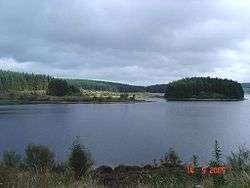Llyn Brenig
| Llyn Brenig | |
|---|---|
 | |
| Location | Conwy & Denbighshire |
| Coordinates | 53°05′N 3°32′W / 53.083°N 3.533°WCoordinates: 53°05′N 3°32′W / 53.083°N 3.533°W |
| Type | reservoir |
| Basin countries | United Kingdom |
| Max. length | 4km (2.5mi) |
| Max. width | 1.6km (1mi) |
| Surface area | 920 acres (3.7 km2) |
| Shore length1 | 9 mi (14 km) |
| 1 Shore length is not a well-defined measure. | |
Llyn Brenig is a reservoir located in Wales, in the heart of the Denbigh Moors, at a height of 1200 feet, on the border between the counties of Conwy and Denbighshire. It is used to manage the flow in the River Dee as part of the River Dee regulation system which is designed to protect the water supply for North West England and north-east Wales, particularly Liverpool and its surrounding area.
Construction and operation
Construction began in 1973 and was completed in 1976. It has a capacity of 60 million m³ and was first filled in 1979. With a surface area of around 920 acres (3.7 km2), it is the fourth largest lake in Wales, behind Llyn Tegid (Bala Lake), Llyn Trawsfynydd and Lake Vyrnwy. The lake has a perimeter of some 9 miles (14 km).
The catchment of the reservoir is very significantly over-reservoired. This means that the reservoir cannot fill from its own catchment within one annual hydrological cycle. When the reservoir level is drawn down, it can take several years for it to completely re-fill again.[1] Llyn Brenig is therefore only used during drought conditions when the capacity of Llyn Celyn and Llyn Tegid are no longer predicted to be capable of maintaining the flow in the River Dee.
Archaeology
During construction of the lake, a number of Bronze Age artifacts were found, as was a camp used by Mesolithic hunter/gatherers. This has been dated by radiocarbon analysis of the charcoal from their fires to around 5700 BC. There are a number of archaeological trails around Llyn Brenig; the relics visible include a ring cairn (a Bronze Age burial mound), and several barrows.
A visitor centre to the south of the lake displays a lot of archaeological information about the area.
Watersports
A number of watersports take place on the lake, including sailing, fishing, and canoeing. The only power craft allowed on the lake are those used by fishermen, Rangers' patrol boats and sailing club safety craft. In 1990 it was selected as the only Welsh reservoir used for the World Fly Fishing Championships.[2]
References
- ↑ H Smithers, S Walker (April 1997). "Reassessment of water resources in northwest England as a result of the 1995-1996 drought" (PDF). Sustainability of Water Resources under Increasing Uncertainty (Proceedings of the Rabat Symposium S1). IAHS. p. 179. Retrieved 22 January 2010.
- ↑ http://www.aboutbritain.com/LlynBrenigReservoirVisitorCentre.htm